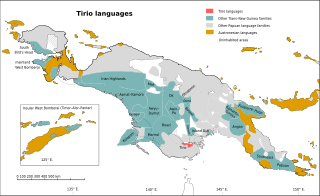
The Trans-Fly – Bulaka RiverakaSouth-Central Papuan languages form a hypothetical family of Papuan languages. They include many of the languages west of the Fly River in southern Papua New Guinea into southern Indonesian West Papua, plus a pair of languages on the Bulaka River a hundred km further west.

The Eastern Trans-Fly languages are a small independent family of Papuan languages spoken in the Oriomo Plateau to the west of the Fly River in New Guinea.
Nicholas "Nick" Evans is an Australian linguist and a leading expert on endangered languages. He was born in Los Angeles, USA.

The Kiwaian languages form a language family of New Guinea. They are a dialect cluster of half a dozen closely related languages. They are grammatically divergent from the Trans–New Guinea languages, and typically have singular, dual, trial, and plural pronouns.

The Tirio languages are a family of Trans–New Guinea languages in the classification of Malcolm Ross. The Tirio languages have about 40% of their lexicon in common.

The Yam languages, also known as the Morehead River languages, are a family of Papuan languages. They include many of the languages south and west of the Fly River in Papua New Guinea and Indonesian West Papua.

The Pahoturi River languages are a small family of Papuan languages spoken around the Pahoturi. This family includes eight language varieties including Agöb (Dabu), Em, Ende, Idan, Idi, Idzuwe, Kawam, and Taeme, which are spoken in the Pahoturi River area south of the Fly River, just west of the Eastern Trans-Fly languages. Idzuwe is no longer spoken. Ross (2005) tentatively includes them in the proposed Trans-Fly – Bulaka River family, though more recent work has classified Pahoturi River as an independent family within the region.
The Trans-Fly languages are a small family of Papuan languages proposed by Timothy Usher, that are spoken in the region of the Fly River.

Morori is a moribund Papuan language of the Kolopom branch of the Trans–New Guinea family. It is separated from the other Kolopom languages by the intrusive Marind family. All speakers use Papuan Malay or Indonesian as L2, and many know Marind.
Kiwai is a Papuan language, or languages, of southern Papua New Guinea. Dialects number 1,300 Kope, 700 Gibaio, 1,700 Urama, 700 Arigibi, 3,800 Coast, 1,000 Daru, 4,500 Island, 400 Doumori. Wurm and Hattori (1981) classify Arigibi as a separate language.
Ngkolmpu Kanum, or Ngkontar, is part of a dialect chain in the Yam family spoken by the Kanum people of New Guinea. The Ngkâlmpw (Ngkontar) and moribund Bädi varieties have limited mutual intelligibility may be considered distinct languages.

Tabo, also known as Waia (Waya), is a Papuan language of Western Province, Papua New Guinea, just north of the Fly River delta. The language has also been known as Hiwi and Hibaradai.
Yelmek, also rendered Jelmek or Jelmik, is a language of the proposed Trans-Fly – Bulaka River family in West Papua.

The Agöb languages are a group of Pahoturi languages spoken in eastern Morehead Rural LLG, Western Province, Papua New Guinea. The language varieties include Agöb, Ende, and Kawam. Languages in this group, along with the Idi language, form a dialect chain with the Idi and Agob dialects proper at the ends of the chain.
Bitur is Papuan language of Western Province, Papua New Guinea.
Nen is a Yam language spoken in the Bimadbn village in the Western Province of Papua New Guinea, with 250 speakers as of a 2002 SIL survey. It is situated between the speech communities of Nambu and Idi.

Baluan-Pam is an Oceanic language of Manus Province, Papua New Guinea. It is spoken on Baluan Island and on nearby Pam Island. The number of speakers, according to the latest estimate based on the 2000 Census, is 2,000. Speakers on Baluan Island prefer to refer to their language with its native name Paluai.

Morehead Rural LLG is a local-level government (LLG) of Western Province, Papua New Guinea. Merauke Regency, Indonesia is located adjacently to the west. Yam, Pahoturi, and Anim languages are spoken in the LLG.
Taeme is a Pahoturi language spoken in Kondobol ward, northeast Morehead Rural LLG, Western Province, Papua New Guinea. It is spoken by 834 people in Taeme village, Kondobol ward, Morehead Rural LLG.
Nambo-Namna is a Yam language spoken in Western Province, Papua New Guinea. The two varieties are mutually intelligible. They are,










